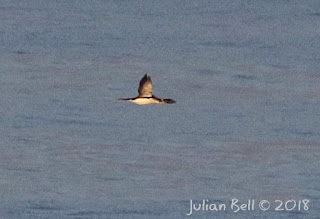Calm and sunny during the morning, northerly breeze later.
Given the weather forecast combined with the dull and wet conditions of the last couple of days I somewhat predictably spent the first few hours of the day seawatching. Things went almost exactly as expected - a very decent passage of Common Gulls fiskemåke, the first Red-throated Diver smålom of the year and some Cormorant storskarv and Shag toppskarv migration. Over 3000 birds logged.
The Common Gulls fiskemåke passed at height and generally at long range, although some flocks passed overhead.
Other birds of note were a single Great Northern Diver islom and a couple of Shelduck gravand heading north.
Passerines were thin on the ground, though a few Skylark sanglerke passed overhead.
Woodcock rugde roding over my house again in the evening.
The totals for a little over three hours seawatching (07:00-10:10) were as follows:
Given the weather forecast combined with the dull and wet conditions of the last couple of days I somewhat predictably spent the first few hours of the day seawatching. Things went almost exactly as expected - a very decent passage of Common Gulls fiskemåke, the first Red-throated Diver smålom of the year and some Cormorant storskarv and Shag toppskarv migration. Over 3000 birds logged.
Migrating Common Gulls fiskemåke
Some gull flocks passed overhead - here with a lone Black-headed Gull hettemåke amongst them
Cormorants storskarv have started migrating now
Great Northern Diver islom on it's way north
Two of the three Linnets tornirisk seen during a drive-by at Herdlevær after the seawatching
Rock Pipit skjærpiplerke at the lookout point - obviously part of a pair that has settled in for the season
One of many southbound Shag toppskarv flocks today
Shelduck gravand pair. The white specks above and below them are instantly recognisable as distant Common Gulls fiskemåke
The Common Gulls fiskemåke passed at height and generally at long range, although some flocks passed overhead.
Other birds of note were a single Great Northern Diver islom and a couple of Shelduck gravand heading north.
Passerines were thin on the ground, though a few Skylark sanglerke passed overhead.
Woodcock rugde roding over my house again in the evening.
The totals for a little over three hours seawatching (07:00-10:10) were as follows:
| Red throated Diver N | 1 |
| Great Northern Diver N | 1 |
| Northern Gannet S | 5 |
| Great Cormorant N | 82 |
| Great Cormorant S | 2 |
| Eurasian Shag N | 4 |
| Eurasian Shag S | 190 |
| Greylag Goose S | 2 |
| Shelduck N | 2 |
| Eider S | 4 |
| Common Scoter S | 18 |
| Merganser N | 2 |
| Merganser S | 2 |
| Oystercatcher N | 8 |
| Eurasian Curlew N | 2 |
| Black headed Gull N | 4 |
| Common Gull N | 2790 |
| Common Guillemot N | 2 |
| Auk N | 1 |
The Shag toppskarv count was rather high for the time of year (normally this species passes in this kind of number earlier in the year). The very small numbers of Oystercatcher tjeld is perhaps surprising but there has been a lot of good migration weather of late and the peak is probably past.









No comments:
Post a Comment